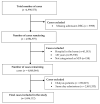The Frequency of, and Factors Associated with Prolonged Hospitalization: A Multicentre Study in Victoria, Australia
- PMID: 32971851
- PMCID: PMC7564707
- DOI: 10.3390/jcm9093055
The Frequency of, and Factors Associated with Prolonged Hospitalization: A Multicentre Study in Victoria, Australia
Abstract
Background: Limited available evidence suggests that a small proportion of inpatients undergo prolonged hospitalization and use a disproportionate number of bed days. Understanding the factors contributing to prolonged hospitalization may improve patient care and reduce the length of stay in such patients.
Methods: We undertook a retrospective cohort study of adult (≥20 years) patients admitted for at least 24 h between 14 November 2016 and 14 November 2018 to hospitals in Victoria, Australia. Data including baseline demographics, admitting specialty, survival status and discharge disposition were obtained from the Victorian Admission Episode Dataset. Multivariable logistic regression analysis was used to identify factors independently associated with prolonged hospitalization (≥14 days). Cox proportional hazard regression model was used to examine the association between various factors and in-hospital mortality.
Results: There were almost 5 million hospital admissions over two years. After exclusions, 1,696,112 admissions lasting at least 24 h were included. Admissions with prolonged hospitalization comprised only 9.7% of admissions but utilized 44.2% of all hospital bed days. Factors independently associated with prolonged hospitalization included age, female gender, not being in a relationship, being a current smoker, level of co-morbidity, admission from another hospital, admission on the weekend, and the number of admissions in the prior 12 months. The in-hospital mortality rate was 5.0% for those with prolonged hospitalization compared with 1.8% in those without (p < 0.001). Prolonged hospitalization was also independently associated with a decreased likelihood of being discharged to home (OR 0.53, 95% CI 0.52-0.54).
Conclusions: Patients experiencing prolonged hospitalization utilize a disproportionate proportion of bed days and are at higher risk of in-hospital death and discharge to destinations other than home. Further studies are required to identify modifiable factors contributing to prolonged hospitalization as well as the quality of end-of-life care in such admissions.
Keywords: bed utilization; hospitalization; length of stay; mortality.
Conflict of interest statement
The authors declare no potential conflict of interest.
Figures


References
-
- OECD . Health at a Glance: Europe 2018. OECD Publishing; Paris, France: European Union; Brussels, Belgium: 2018. Health expenditure in hospitals; pp. 138–139. - DOI
LinkOut - more resources
Full Text Sources

